(1401-1437)
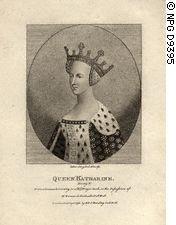
Katherine of Valois
Neglected by her parents, overshadowed by her iconic husband Henry V, pushed to one side during the minority of her young son Henry VI, and subsequently dismissed by historians and biographers as nothing more than a perpetual footnote in accounts of the history of her time, through the centuries the story of Katherine of Valois has largely been forgotten. Immortalised by Shakespeare as Henry V’s ‘Fair Katherine’, she has nevertheless remained an enigma with so little written about her that it is easy to forget the fact that, independently of either her legendary husband or tragic son this Queen unwittingly had a dramatic and lasting impact on English history.
A French princess who became Queen of England, from childhood her personal life was full of drama and intrigue. She was close to many of the leading personalities of her day; and lived as a prominent member of the royal courts of both France and England during some of the most turbulent times in their history. Her first marriage brought peace between France and England while her second founded a dynasty. The daughter, sister, wife and mother of Kings, this forgotten Queen changed the course of English history, simply by following her heart.
Despite her high rank Katherine’s early years were largely dismal and impoverished. The tenth child of King Charles VI of France and his Queen, Isabeau of Bavaria, Princess Katherine was born in the royal palace Hotel de Saint Pol, Paris on 27thOctober 1401. At the time of her birth France was in chaos and her family in turmoil due to her father’s persistent bouts of insanity. A well-loved and widely respected monarch, from as far back as 1393 King Charles had suffered attacks of lunacy; which, as time went on, had increased in both frequency and duration.
By the time Katherine was three years old the outlook for the King’s sanity looked grave; and it was decided that, for the sake of his health and dignity he should retire from public life. The Hotel de Saint Pol, a secluded royal residence, home to Katherine, her siblings and the other members of the royal nursery was chosen as the place best suited to house the unfortunate King.
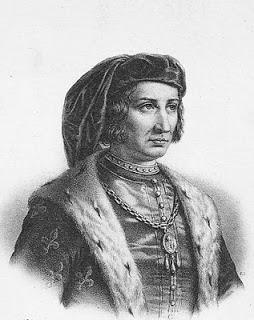
King Charles VI of France
With the King now shut away and heavily guarded in Saint Pol, the political fallout become apparent. In the absence of a strong and determined leader disorder quickly grew within the French government. Queen Isabeau, a shamelessly unfaithful wife, known for her arrogance and ruthless ambition, viewed her husband’s misfortune as a golden opportunity for self-advancement.Enlisting the aid of her brother Louis, Duke of Bavaria, and her besotted brother-in-law Louis, Duke of Orleans, she managed through a series of calculated political manoeuvres, to seize control of the government of Francefrom the rival forces of the King’s cousin John, Duke of Burgundy
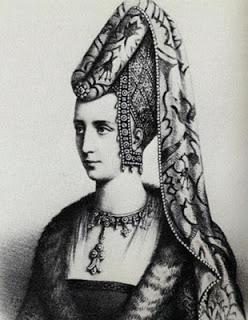
Isabeau of Bavaria, Queen of France
Her mission completed, the wildly unpopular Queen was soon devoting her time exclusively to the pursuit of pleasure, pilfering the treasury and showering her favourites with riches. In contrast, contemporary chroniclers noted the ‘piteous state’ of the young Princess Katherine and her siblings, ‘nearly starved and loathsome with dirt, having no change of clothes, nor even of linen’. The Queen was so negligent that she made no provision for her husband and children. Content that they remain locked away, far from sight, she neglected to ensure that the servants at Saint Pol were being paid for their labour, with the result that, as time went on, more and more were forced to find work elsewhere, leaving the royal children and their ailing father wholly dependent on the few faithful servants who remained.
The desperate situation at Saint Pol was temporarily relieved when the King unexpectedly regained his senses. Taking stock of the deplorable situation that surrounded him, the King immediately set about rectifying matters and much to his wife’s dismay resumed his royal role with almost immediate effect. For their own safety the Queen and Duke of Orleans were forced to flee to Milan, while the Queen’s brother was ordered to follow with the royal children. Although temporarily defeated the wily Isabeau was confident that in time she could win over her husband, in the meantime the children she had so callously neglected could be used as valuable pawns when negotiating her return to Paris and the power she craved.
Before the King’s forces could intercept him the Duke of Bavaria had seized the children, carrying off Princess Katherine, her sisters Michelle and Marie, and most significantly of all, the heir to the throne, Dauphin Louis, and his brothers Jean and Charles. But the over-zealous Duke made a grave error for in his haste he also seized the children of the Duke of Burgundy. Philip of Burgundy, was already betrothed to the Princess Michelle, and with his sister, lived as companions to their royal playmates. This was a step too far and before long the outraged Burgundians had intercepted the party and the furious Duke was forced to surrender the children who were swiftly returned to Paris.
While her brothers remained at court and her sister Michelle was given to the care of the Duke of Burgundy, with no sign of an end to the power-struggles and feuding at court, it was decided that Princesses Katherine and Marie should be sent to the convent of Poissy. There they would be far from their mother’s influence and could receive the education suitable for princesses of their rank.
While Katherine was spending her days in the seclusion of Poissy, far from the drama and intrigue that had blighted her early years, France was teetering on the brink of civil war. Despite his temporary recovery the King’s health remained precarious and before long, to the dismay of his supporters, was forced to retreat once more to the sanctuary of Saint Pol. This sparked a bloody feud between the rival forces of ‘The Burgundians’ led by John the Fearless, Duke of Burgundy, and ‘The Armagnacs’ led by Louis of Orleans and his father-in-law, Bernard of Armagnac; eachanxious to turn the King’s illness to their own advantage by seizing control of the throne of France.
By 1411 with the King still frequently incapacitated and the Dauphin not yet of age, open civil war broke out between the two groups. Burgundyat first held control of the government, but in 1413 John the Fearless and his supporters were ousted and forced to flee the city. With the Queen flitting from one side to the other, the Armagnacs came into power and conducted the defence of Franceagainst the English, who were already making war-like gestures towards their weakened enemy.
By this time Princess Katherine had been recalled to court. As the only one of the royal princesses who was neither betrothed nor destined for the convent, the once neglected Katherine was now a valuable asset to her beleaguered family and had already come to the attention of the English King. In 1413 Henry IV had proposed a match between the young princess and his eldest son. The English King had previously made unsuccessful advances towards Katherine’s sisters, Isabelle, the widow of Richard II, and Marie who was by that time a novice in the convent of Poissy. While the negotiations for Katherine’s hand were pending Henry IV died and his son came to the throne as Henry V. Young and dynamic it soon became clear that he was set upon a French match, and not one to be easily deterred, he now renewed his suit.
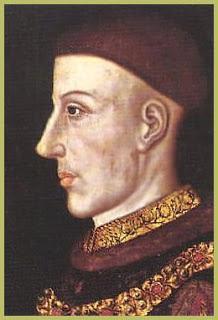
King Henry V of England
Although his initial approaches were refused by the French who were outraged by the excessive dowry he demanded and fearful that a match with their princess might encourage Henry to renew his own claim to the French throne, Henry was not to be dissuaded. In fact this was just the excuse he needed and he began preparing for an invasion of France.
To show he was in earnest, before his departure Henry sent a letter to the French King repeating his demands for two million crowns, the restoration of Normandy, the southern provinces and the hand of the Princess Katherine. The beleaguered French King replied, ‘…if that was his mind he would do his best to receive him; but as to the marriage, he thought it a strange way of wooing Katherine, covered with the blood of her countrymen…’The wild and reckless Dauphin Louis went one step further; he sent the English King a casket of tennis balls, declaring that he thought them fitter playthings for him than the provinces he demanded. Henry’s furious response is well documented, he replied ‘These balls shall be struck back with such a racket as shall force open Parisgates.’There could be no going back, and with the tacit approval of the Duke of Burgundy, in 1415 Henry V launched his invasion of France.
Henry V’s decisive and somewhat unexpected victory at Agincourt, threw all of France into chaos. The huge numbers of French noblemen who were slain and taken prisoner greatly boosted his cause and weakened the divided Francestill further. On 27th November 1415 Henry returned to England a hero, and for a while at least, appeared to have given up his pursuit of Katherine. To the consternation of Queen Isabeau there were reports that shortly after his return from Francethe King’s valet Robert Waterton was despatched to open private negotiations for the hand of the Princess of Aragon, but it appears these reports, if true, came to nothing.

Battle scenes from the Hundred Years War
While Henry was in England, contemplating his next move, as his men maintained the advantage in France, Katherine and her family were thrown into turmoil by the sudden death of her eldest brother Dauphin Louis. Rumoured to have been accelerated by despair, following the defeat at Agincourt, the Dauphin’s death was followed so swiftly by the unexpected demise of his brother Prince Jean, that all France was gripped with panic. To lose one heir was unfortunate, to lose two, at what many would consider the lowest point in their history, was nothing short of catastrophic. As was usual with sudden deaths rumours of poisoning abounded and Queen Isabeau, their estranged mother, was the prime suspect.For the past few years, to prevent her persistent meddling in politics, she had been restrained at the palace of Tours. The deaths of her elder sons left the way clear for her to renew her efforts to seize control of the throne, this time through her youngest son Charles, who at the tender age of twelve was now his father’s sole heir.
Unable to process these latest developments and overcome with grief the hapless King remained in a state of delirium. As the Burgundians and Armagnacs continued their feud, and Paris was convulsed with anarchy, pestilence, and famine, the Queen seized her opportunity. With the aid of her sometime ally the Duke of Burgundy she escaped from Toursand showing that she had lost none of her wiles, with Burgundy’s support, swiftly took control and declared herself regent. Katherine and her brother Charles were now once more in their mother’s possession.
However much she may have neglected her daughter in the past, following their reunion, it appears that Katherine gained great influence over her mother whose, ‘maternal feelings seemed centred in her [Katherine] alone, to the unjust exclusion of her other children.’ While this may have had more to do with the fact that Katherine was now the most valuable asset the House of Valois possessed, from that point on Queen Isabeau appears to have decided that the path to success lay in devoting her energies to securing her daughter’s future rather than her son’s throne.
By 1417 Henry V was ready to renew his campaign. At this stage his successes had made him virtually master of Paris, yet he was in no rush to complete his mission and remained in Normandy, which was now almost completely under English control. Anxious for an amicable settlement, and keen to reopen negotiations, the pragmatic Isabeau, saw a match between Katherine and Henry as the only way to salvage the situation. It was rumoured that Princess Katherine, aware, perhaps of Henry’s previous proposals, and flattered by his interest and the prospect of a crown, ‘had very early set her mind on being Queen of England’ and that she was not averse to her mother’s schemes. Taking matters into her own hands the Queen sent her ambassadors to Henry with a portrait of the young daughter, already known to her people as ‘Katherine the Fair’ because of her good looks; and ordered them to enquire whether so beautiful a princess required so great a dowry. Her plan failed, for although the King declared Katherine, ‘surpassingly fair’ to Isabeau’s irritation he remained immovable.
By the close of 1418 Rouen had fallen into English hands and a peace conference was held at Melun. Confident that her daughter’s personal charms would succeed where her portrait had failed, the determined Queen ensured that Katherine was included as one of the party. In the richly ornamented enclosure at Pontoise, seated on opposing sides, both surrounded by men-at-arms, Katherine of Valois was first introduced to her future husband. Although the King appeared quite taken with the French princess, he still made no effort to lower his demands. Outraged at this stalemate, the Queen decided to take action and at the next meeting, Katherine was nowhere to be seen. Contemporary chroniclers note the King’s anger, and declare that by now ‘…it was plainly to be seen that King Henry was desperately in love.’
After a few days Henry impatiently demanded another meeting, but on arriving at Pontoise he discovered the tents and barriers had all been pulled down and that the French royal family had already departed for Paris. His anger seems to indicate the extent to which the Queen’s plan had worked. Turning roundly on Philip of Burgundy, the only French representative present Henry declared, ‘Fair cousin, we wish you to know that we will have the daughter of your King, or we will drive him and you out of his kingdom!’
With Isabeau now plotting furiously to ensure the match went ahead, and the English forces inching ever closer to the gates of Paristhe war between the Burgundians and the Armagnacs waged on. Anxious to distance himself from a mother who seemed determined to put his sister’s future before his own, the young Dauphin Charles had fallen under the influence of Bernard VII, leader of the Armagnacs.When Bernard and many of his followers were massacred in a Burgundian attack, things rapidly spiralled out of control. In 1419 during an attempt to negotiate a truce with the fifteen-year-old Dauphin, John the Fearless was assassinated. The murder shocked all of France. His outraged son and successor, Philip of Burgundy, anxious to avenge his father’s murder by punishing the Dauphin, immediately concluded a treaty with the English and offered Henry his full support in future campaigns.
With nothing to stand in his way, by 1420 Henry was asked to name his own terms for peace. His response ‘…that he had been deceived and baffled so many times that he would treat with no one but the princess Katherine herself, whose innocency, he was sure, would not try to deceive him.’ indicates that despite his fury with the French, he still held their princess in high regard.
On hearing this, Queen Isabeau, ever anxious to remain on the winning side, immediately sent the Bishop of Arras to deliver a message telling Henry that if he would travel to Troyes, she would agree to his marriage with her daughter Katherine; as an added incentive, she revealed that following the marriage, she would ensure that after the death of the ailing King Charles the crown of France passed to Henry, Katherine and their heirs.
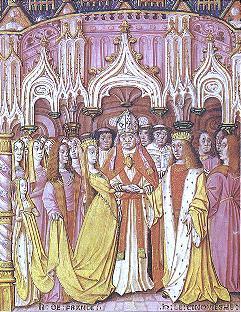
The Treaty of Troyes
These terms, which reversed the sovereignty of France and disinherited the Dauphin, were made official in the Treaty of Troyes. While her distressed husband remained out of sight and her dispossessed son, Dauphin Charles retreated to Bourges, Queen Isabeau gave the Treaty her wholehearted approval. If Katherine had any reservations about disinheriting her brother they were never documented, and it seemed to her contemporaries that despite the harshness of the treaty Katherine remained almost as keen for the match as her mother. Whatever her motives, Philip of Burgundy declared that from the moment of their first meeting, the princess ‘had passionately longed to be espoused to King Henry’. Henry and Katherine were betrothed on 21st May 1420 and a few weeks later were married in a magnificent ceremony at Troyes. According to one contemporary, such pomp and magnificence was displayed during the ceremony, ‘as if he had been king of the whole world…’
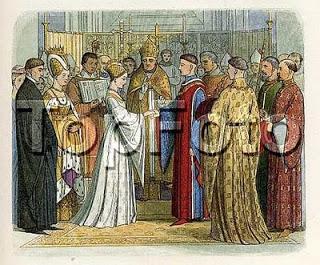
Wedding of Henry V and Katherine of Valois
Along with all his previous demands, Henry was now, through this marriage, named as the heir to the French throne and, Katherine, the once impoverished princess was Queen of England.
After visiting Sens, conducting a winter tour through Franceand celebrating Christmas in Paris, Henry and his new Queen made their way to Calais where they set sail for England, arriving at Doveron 1st Feb 1421. The new Queen of England received a rapturous welcome, with one chronicler declaring that Katherine; ‘was received as if she had been an angel of God.’
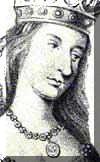
Katherine of Valois, Queen of England
On 24thFebruary in a magnificent ceremony Queen Katherine was crowned at Westminster where an elaborate feast was held in her honor. Biographer, Agnes Strickland, notes that it was during her coronation feast that ‘the only instance of active benevolence ever recorded of Katherine the Fair took place.’ Seemingly indifferent to the plight of her own brother and defeated country, on arrival in England, the new Queen was soon showing her softer side. Katherine had befriended the young James, King of Scots, who having been captured by the English while still a boy, had spent most of his life as a prisoner at the royal court. By all accounts handsome, lively and affable, and a great favorite of the King’s, James had recently fallen in love with Joanna Beaufort, a renowned beauty of the English court, but in his present situation marriage was impossible. Obviously taken with the plight of these young lovers Queen Katherine was determined that her new friend be restored to his kingdom, and pleaded with her husband on his behalf. To Katherine’s joy Henry relented, arrangements were put in place for the King’s return to Scotland and the young couple were betrothed before the festivals of Katherine’s coronation had ended.
Despite this promising beginning Katherine was soon to discover that paying court to his young wife was not high on Henry’s list of priorities. Although attentive and considerate, from the outset Henry was preoccupied with the war in France, and thought nothing of parading his young wife through the streets of England, ‘as proof of the progress he had made in the conquest of France.’ While the crowds cheered their beautiful Queen, Henry, a skillful orator, would remind them that there was still work to be done, and that funds and forces were needed to complete the task.As the year progressed Katherine accompanied her husband on a northern tour. It was during this time the Queen discovered that she was pregnant.
Henry’s delight at the prospect of an heir for the thrones of Englandand Francewould prove to be short-lived. In the summer of 1421, Henry received word that his brother, Thomas, Duke of Clarence had been slain at the field of Baugy. Burning to avenge Clarence, Henry abandoned his plans to remain in England until the birth of his heir, and returned to France, leaving his young wife in the care of his brother John, Duke of Bedford. Before taking leave of his wife, Henry made her promise that she would not let the baby be born at Windsor. Some chroniclers believe that the King had studied the planets, and in that way ‘prophesised the calamities’ to come, whatever the reason behind it, Henry was adamant that the birth should not take place at Windsor. Yet inexplicably, it was in that very place on 6th December 1421 that the future Henry VI was born.
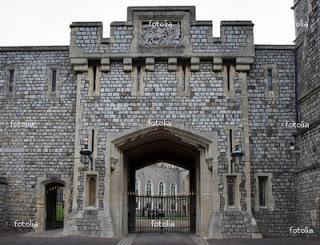
Windsor Castle
At the time the news reached him the King was pursuing the siege of Meaux. Overjoyed at the birth of a son and heir Henry’s first question was to ask where the child had been born. When told that it was Windsor, Henry is reported to have sighed and turning to his chamberlain Lord Fitzhugh, remarked, ‘I, Henry, born at Monmouth,Shall small time reign and much get:But Henry of Windsor shall long reign and lose allBut as God wills; so be it.’
Oblivious to her husband’s prophetic response, Queen Katherine remained on in England, overseeing the christening of her new son. As Queen, Katherine enjoyed a comfortable existence, far removed from her early days in France. She appears to have been unaware that her household expenses were in fact being paid from the dower of Queen Joanna, her husband’s stepmother, who had recently fallen into disfavour. Seemingly content to remain somewhat aloof she made no strong alliances one way or the other while at court. Katherine’s maids, Joanna Belknap, Joanna Courcy, Joanna Troutbeck, Agnes (whose surname is unknown) along with her lady of the bedchamber, a Frenchwoman named Guillemote, formed the core of her circle of intimates, along with a more regal guest, Jacqueline of Hainault. The feisty and troublesome Jacqueline, one of Europe’s richest heiresses, had recently taken refuge at the English court having left her husband, the powerful Duke of Brabant. A childhood acquaintance, and widow of Katherine’s brother Prince Jean, Jacqueline was soon on intimate terms with the Queen and before long was conducting a controversial romance with the King’s ambitious younger brother, Humphrey, Duke of Gloucester.
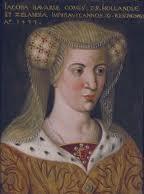
Jacqueline of Hainault
Despite her charmed existence as Queen and young mother, as a Frenchwoman in a foreign court Katherine must have felt somewhat isolated. In the spring of 1422, with no sign of her husband returning, she wrote a letter, ‘declaring that she earnestly longed to behold him once more’. Before long, having received permission from Henry, Queen Katherine left her infant son in the care of his uncle, the Duke of Gloucester, and was setting sail for France and a reunion with her husband.
On 21stMay 1422 Queen Katherine landed at Harfleur accompanied by the Duke of Bedford and twenty thousand men at arms, reinforcements for the English army. On learning of their arrival Henry V left the recently captured Meaux and, accompanied by Katherine’s parents, made his way to Bois de Vincennes, where they were reunited. On 30th May the royal party advanced towards Paris where great celebrations were held in honor of the arrival of the Queen and birth of an heir. Queen Katherine and her party took up residence at the Louvre, while her parents were lodged at Hotel de Saint Pol. The following day Queen Katherine ‘held a great court, and all the Parisians went to see their princess and her lord sitting enthroned, crowned with her most precious diadems…but as no meat or drink was offered to the populace, they went away much discontented.’ The absence of the largesse they were accustomed to receiving had no doubt angered the grumbling crowds, but it was the sight of their well-loved King, ‘seated at table with his queen, quite forsaken by his nobles, who all flocked to pay their court to his daughter and her husband, at which the common people grieved much’. In contrast to her rapturous reception in England, the French people were angered by what they perceived as Katherine’s arrogance, and it is reported that she ‘gave great offense by having the ermines carried before her coach, as if she had been sovereign of France’
But the young Queen had more to occupy her mind than the grumbling Parisian crowds. Shortly after her arrival it became clear that the constant battles of the past few months, and the siege of Meaux in particular, had broken her husband’s health and the once strong and vibrant soldier-King was now gravely ill with dysentery. Refusing to admit his limitations and determined to continue on with the conquest of France, the ailing King donned his armor and prepared to join his ally Burgundy, who was at that time in battle against the Dauphin. Although he had marched as far as Melun, the King was eventually gripped with pain, and, unable to continue, endured the humiliation of having to be carried back to the palace of Vincennes in a litter. It was obvious to all who saw him that the end was near.
Although his final hours were almost exclusively preoccupied with establishing a protectorate for his son and heir, the King did spare a thought for his young Queen; consigning her to the care of his brother Bedford, he declared his ‘dear wife…the most afflicted creature living’. Shortly after speaking these words, on 31st August 1422 the legendary Henry V died, leaving his Queen a widow at the tender age of twenty-one.
While Katherine’s grief was reported to be ‘most violent’, she was composed enough to lead her husband’s stately funeral cortege as it made its way to back to England. On her arrival in Londonthe young Queen-Dowager was greeted by fifteen bishops, an assortment of abbots, priests and hundreds of mourners who lined the streets, singing hymns and chanting prayers for their dead King. It was reported that the sight of their grief-stricken Queen, ‘greatly edified the people’.
Following the funeral Queen Katherine retired to Windsorwhere she was reunited with her son, now King Henry VI. Shortly after her arrival in Englandshe had received word that, after many years of illness and suffering, her father had passed away, her infant son was now King of England and France. For the first few years of her widowhood Katherine spent most of her time with her son. The young Queen was sometimes called upon to take part in state processions, and contemporaries describe how often on such occasions, ‘the infant king was seated on her lap’. She spent the Christmas of 1423 at Hertford in the company of her good friend James of Scotland, whose marriage to Lady Joanna Beaufort she had the pleasure of witnessing not long afterwards.
In the second year of her son’s reign Katherine’s dower was settled by an Act of Parliament. The dower was a generous 40,000 crowns, (or 10,000 marks), as part of the Treaty of Troyes it had been arranged that, in the event of Katherine’s widowhood, she would receive an annuity of 20,000 crowns. Henry had also settled on his widow an income from his personal Lancastrian estates, as well as from the Bohun inheritance of his mother. The widowed Queen was well-provided for, yet her position was not an easy one. She was young, beautiful and rich, yet as mother of an infant King, her future was neither simple nor settled. In theory, as a princess of France, she might have decided to retire to her homeland, as many dowagers had done before, but with her son declared titular King of France and her own brother the Dauphin raging a war against English occupation, for Katherine a return home was unthinkable.
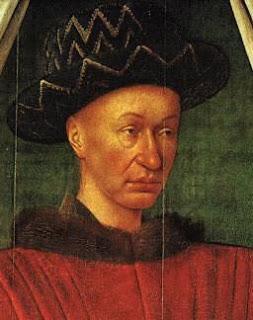
Katherine's brother the Dauphin Charles, who would eventually rule France as King Charles VII
Similarly the matter of a remarriage brought with it myriad complications. Henry V had gone to great lengths to ensure the stability of the joint kingdoms of France and England, a Council of trusted advisors, led by Humphrey of Gloucester, was to oversee the government of England, while John of Bedford was declared regent in France. It was feared that, if this highly desirable young widow decided to marry, her husband might gain undue influence over his young stepson and upset the balance of power. Katherine’s nationality was also never far from their minds, if she should decide to ally herself with a member of the French nobility, the situation would be even more fraught with difficulties. Thus the Council remained watchful, Katherine may be Queen-Dowager, and the mother of their young sovereign, but she was also a Frenchwoman, and there were many who began to feel that her influence over her son was both dangerous and undesirable.
Despite this climate of suspicion, as an intimate acquaintance of both parties, in 1423 Katherine was called upon to end the feud, which had developed between Humphrey of Gloucester and Philip of Burgundy. Former allies the two had quarrelled bitterly over Humphrey’s hasty and controversial marriage to Katherine’s childhood friend Jacqueline of Hainault. The short-lived marriage which had sparked Humphrey’s dynastic ambitions, had also caused outrage in Europe, Katherine’s intervention was credited with resolving the matter. She also continued an active role in her son’s life, and as late as 1425 accompanied him in a grand procession before the opening of parliament. But it was not to last.
Sometime in 1425 it was decided that the King should be removed from his mother’s care. A separate household had already been established for this purpose, a governess Dame Alice Boteler and nurse Joan Astley were appointed and the Earl of Warwick, was formerly given the guardianship of the young king.
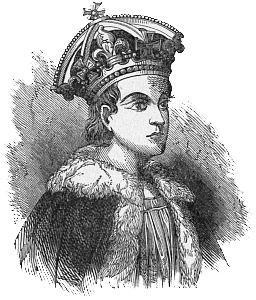
Artist's impression of a young King Henry VI
With the King’s household now settled, Queen Katherine, with rare exceptions, appears to have retired from public life. While no doubt relieved that Katherine did not share her mother’s passion for politics, the subject of a possible remarriage continued to trouble the Council. In 1428 the Duke of Gloucester, still smarting from his failed attempt to secure his wife’s lands in Europe and the subsequent annulment of his marriage, reacted to rumours that Katherine intended to make a match with Edmund Beaufort, Earl of Somerset, a cousin of the late King, by persuading Parliament to pass a law prohibiting any person from marrying the queen-dowager without the consent of the King and Council. Despite Gloucester’s paranoia there appears to have been little truth in the rumours surrounding the Beaufort match. In fact forging a political alliance could not have been further from Katherine’s mind, for the simple reason that by the time the law was passed her life had taken a wholly unexpected turn. In a bold and uncharacteristic move the woman, who from an early age, had set her heart on becoming a Queen and whose own people had criticised for her arrogance and ambition had embarked upon an affair that would change her life forever.
The man with whom Queen Katherine would fall so deeply and dangerously in love was Owen Tudor, a Welshman, who, although belonging to a family of great antiquity, was of relatively modest background. Much of Tudor’s origins are shrouded in mystery, however it is generally agreed that having entered the service of Henry V, he distinguished himself at Agincourt, where he was rewarded with a post as one of the King’s esquires of the body. Following the King’s death Owen had remained on at court to serve the infant Henry VI, and it is as an attendant to her son that he is believed to have come to the attention of the young Queen-Dowager who eventually appointed him Clerk of her Wardrobe.
The origins of their affair have remained secret, but their mutual attraction soon became obvious to Katherine’s intimate circle. The dangers of such an affair and the difficulties of concealing their attachment would soon become apparent to the young couple. While on guard at Windsor during some festivities Owen was required to dance before the court, which included Queen Katherine, who were are told sat on a low seat, surrounded by her ladies. While making an elaborate pirouette the unfortunate man lost his balance and fell headfirst into the Queen’s lap. ‘The Queen’s manner of excusing this awkwardness gave her ladies the first suspicion that she was not entirely insensible to the attractions of the brave Welshman’
Fearful of the consequences should this affair become public knowledge some of her ladies went so far as to remonstrate with their mistress. Appealing to her sense of pride they urged her to cease all contact with Owen Tudor claiming that she, ‘lowered herself by paying any attention to a person who, although possessing some personal accomplishments and advantages, had no princely nor even gentle alliances… but belonged to a barbarous clan of savages, reckoned inferior to the lowest English yeomen.’ But it was to no avail. By this time the Queen and her lover were inseparable and although barred from remarrying without the consent of the Council, Katherine would not hear of giving up her lover. Unwilling to end the relationship yet unable to remain at court where there was a constant threat of exposure, Katherine’s response was to retreat further from court life by retiring to the countryside. And free from the prying eyes of the court, the besotted Queen not only continued her affair, she went one step further and on an unknown date in the early 1430s, Katherine of Valois and Owen Tudor were married.
Living in ‘the utmost retirement’ Katherine and Owen managed to successfully conceal both their marriage and the births of their sons, Edmund, Jasper and Owen. There is no record of Katherine’s attendance at her eldest son’s coronation at Westminster Abbey in November 1429 or his coronation as King of France, which took place in Notre Dame in December 1431. The only official record of her appears to have occurred in 1428 when, on the advice of his governess, Henry VI presented his mother with a valuable ruby ring. Proof perhaps, that despite their lack of contact, the King still held his mother in high regard. It is unclear how much Henry knew of his mother’s secret life, but until he came of age he remained little more than a pawn in the hands of the Council and would have been unable to shield her from its wrath should her secret be revealed. Thus despite being secure in the King’s favour, it remained vital that her remarriage remain a secret.
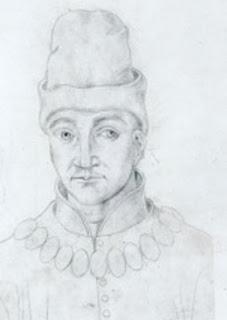
Humphrey, Duke of Gloucester
Towards the end of the summer of 1436, while pregnant with her fifth child rumours of the Queen’s secret marriage appear to have reached the Duke of Gloucester. Upon further investigation the truth of the matter was revealed and the Duke acted swiftly and decisively. We are told that, ‘the high spirit of the Duke of Gloucester could not brook her marriage. Neither the beauty of Tudor’s person nor his genealogy, descended from Cadwallader Kings, could shield him or the Queen from sharp persecution as soon as the match was discovered.’ The Queen’s household was dissolved with immediate effect. Katherine was parted from her children the eldest of whom were sent to live with Katherine de la Pole, sister of the Earl of Suffolk, Owen was confined to Newgate and Katherine was sent to Bermondsey Abbey.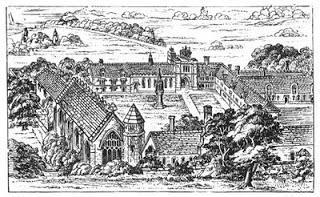
Bermondsey Abbey
By this time the heavily pregnant Queen was gravely ill and deeply distressed by this enforced separation from her husband and children. Not long after entering Bermondsey she gave birth to a daughter, christened Margaret, who died shortly after her birth. Overcome by illness and trauma it appears the Queen never recovered. Even the ‘tablet of gold, weighing thirteen ounces on which was a crucifix set with pearls and sapphires’ an elaborate token of remembrance sent to Bermondsey from her son, Henry VI failed to revive her spirits. On 3rd January 1437, Katherine of Valois, Queen of England died a broken woman.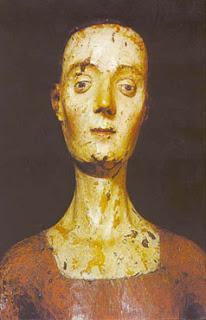
Funeral effigy of Katherine of Valois
Katherine’s body lay in state at St Katherine’s Chapel at the Tower of London. On 18th February 1437 she was taken to St Paul’s Cathederal and buried in the Lady Chapel at Westminster Abbey. Her son Henry VI erected an altar tomb and included an inscription describing her as his father’s widow, no reference to her secret marriage was made. The will she dictated shortly before her death reveals the deep depression of her spirits in those final days. Although no mention is made of either her husband or younger sons, the document, which was addressed to the King, does allude in guarded tones to some intent supposedly known only to him. What Katherine meant by ‘in tender and favourable fulfilling of mine intent…’ remains unclear, although it is generally believed to refer to her wishes regarding her young sons, which may have been revealed to the King at some point before her confinement in Bermondsey.
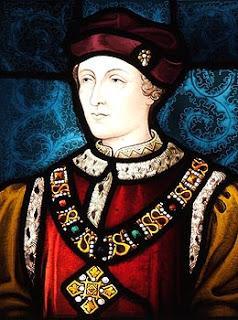
King Henry VI
What is clear is that had Katherine managed to keep her secret until after her son came of age, the outcome would have been very different.We are told that the King, ‘never forgave his uncle Gloucester the harsh usage his mother had experienced’ Once the King came of age Owen Tudor, who had suffered much persecution in the years immediately following Katherine’s death, was awarded an annuity of £40 per annum, and although never graced with a title remained on as a favoured member of the King’s household. Half-brothers Edmund and Jasper were also taken under royal protection and were created Earl of Richmond and Earl of Pembroke respectively (the youngest brother, Owen lived and died a monk at Westminster). As further sign of his approval in 1453 Henry had his brothers declared ‘legitimate’ and in 1455 even went so far as to arrange a royal match for Edmund with Lady Margaret Beaufort, heiress of the House of Somerset, after which ‘Edmund took precedence over all other English peers’
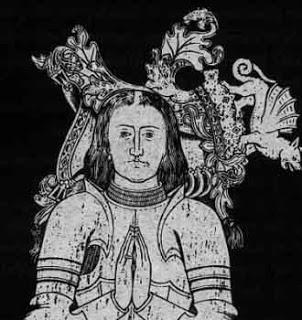
Edmund Tudor, Earl of Richmond
Although she died in disgrace, and was subsequently neglected by historians and biographers alike there was far more to Katherine of Valois than her tragic end. Her short but eventful life was full of drama, tragedy, passion and extremes. From birth she was a political pawn who passively endured poverty, kidnappings and neglect before finally finding high favour as a royal bride in a foreign land. Her marriage to Henry V and the subsequent birth of a son and heir was the pinnacle of her royal career. But it was in following her heart, that the once pliant princess truly made history.
As she lay dying Katherine would have known that the revelation of her second marriage and secret family would send shockwaves through the courts of Europe, outraging both her enemies and supporters alike, but she could have had little idea of the repercussions to come. For in a further twist, although he died in 1456 at the age of twenty, Edmund Tudor left behind a son who, under the guidance of his uncle Jasper came to prominence as Head of the House of Lancaster, and following the chaotic events of the Wars of the Roses, eventually seized the throne as Henry VII, the first of the Tudor Kings.Thus despite its brevity and tragic end the forbidden union of Queen Katherine of Valois and her Welsh squire Owen Tudor unwittingly laid the foundations for one of England’s greatest dynasties.
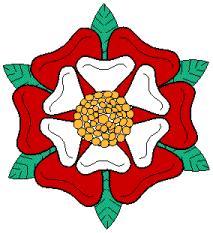
The Tudor Rose
BIBLIOGRAPHY
- Brewer, Clifford; The Death of Kings, (2000)
- Castries, Duc de; Lives of the Kings and Queens of France (1979)
- Crawford, Anne (ed); Letters of the Queens of England, (2002)
- Fraser, Antonia (ed); Lives of the Kings and Queens of England, (1975)
- Hallam, Elizabeth (ed); The Plantagenet Encyclopedia, (1990)
- Mercer, Derrik (ed); Chronicle of the Royal Family, (1991)
- Strickland, Agnes, The Lives of the Queens of England, Volume 2, (1851)
- Stephen, Leslie and Sydney, Lee (eds) Dictionary of National Biography (63 vols 1885-1903)
6486 wordsPublished online www.britannia.com and www.britishhistoryclub.com
"Heidi Murphy is a freelance writer specializing in royal history and biography, currently living and working in London. She is a graduate of University CollegeDublin, has an MA in Early Modern History and presently works in publishing.
